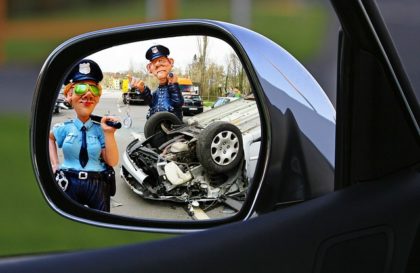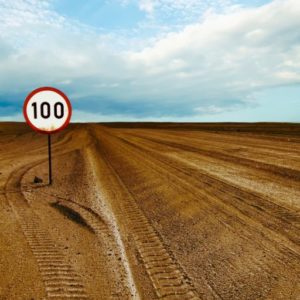 Or, is it just an innocent bystander, blamed because, it’s always present at a crime scene?
Or, is it just an innocent bystander, blamed because, it’s always present at a crime scene?
This is one of the questions the police and Government seems to struggle with.
Learner drivers are taught to learn, sub-consciously. However, experienced drivers, learn to manipulate this skill. Most repetitive actions and routes can be stuffed in to the sub-conscious leaving less to do on a conscious level, freeing up thoughts to wander, this causes a ‘road blindness effect’. Thus, a question has to be asked? is it ‘speed at fault as the primary cause of accidents’ or, it is ‘something else’?
Governments are seen to easily gain and raise funds as the “speed kills” slogan plays such a ‘sole’ reason to want to slow drivers down and “make the roads safer”?
But, is this, correct? Are drivers more likely to get a speeding fine than be involved in an accident due to speeding?
The Road Safety Commission states;
‘Slowing down is the single most effective and immediate way to reduce these statistics. If we all slowed down, our chances of crashing, being killed or seriously injured on the road, would dramatically decrease. Therefore, Western Australia has speed enforcement and penalties for those that go over the speed limit’.
(Visit site here)

However, the belief is that all The state governments boost their revenue funding from speeding fines.
In defence an article published in the Sunday Herald Sun
paints a different story of the Victorian State Government as far back as 2011;
It states;
‘LEAD-FOOT motorists have poured more than $200 million into State Government coffers with new figures showing 146 drivers an hour are caught speeding on Victorian roads.
A comprehensive breakdown of every speeding fine issued in the state, released exclusively to the Sunday Herald Sun, paints a clear picture of how infringements are handed out from mobile, fixed speed cameras and on-the-spot police fines.
- 3500 speeding fines were issued every day – 1.2 million in total – delivering $227 million to the Government last financial year.
- But almost three-quarters of the fines were for the slowest possible category of offence – driving at less than 10km/h over the legal limit.
- More than 923,300 speeding drivers – 72 per cent – booked were traveling less than 10km/h over the limit.
- Fines for the lowest offence netted the Government $137 million.
- Motorists stung by low-range speeding fines said the findings proved road users were being used to fill government coffers.
Truganina motorist Hu Hu Chen received his first and only fine for traveling at 54km/h in a 50km/h zone at Oakleigh last year and said he was still infuriated by the experience. “I thought it was pretty harsh,” he said. “I had no idea until I got the fine in the mail. It’s not like I was hooning around. If I had braked a second earlier, I wouldn’t have even been fined.”
A Northcote resident, who asked not to be named, said speed restrictions in Melbourne’s northern suburbs were getting out of control. “I am hardly what you would call a hoon driver,” he said. “But if I get one more fine I will probably lose my licence for having accumulated so many points. “And each fine has been for exceeding a 50km/h restriction by six-or-so km/h.”
- There were 146 speeding fines issued every hour on average, according to the statistics. That is 2.4 a minute.
- The Government also cashed in on increases in speeding offences, collecting an additional $4.6 million by increasing the cost of individual fines by between $3 and $17.
Police Minister Peter Ryan defended the level of revenue raised
“Those who choose to exceed the speed limit do so with the knowledge they will be penalised,” he said.”Speed and red-light cameras save lives, but the Coalition understands Victorians need to believe cameras are reliable, accurate and operate fairly.”
Victoria Police Road Policing Superintendent Neville Taylor welcomed community debate
but, said police made no apologies for booking motorists just over the limit.
- With speed attributed to 30 per cent of road deaths last year, he warned that police would fine even more speeding drivers this year to bring down the road toll.
- “Often the attitude of people is ‘I was just a little bit over’ but it’s our goal to change that behaviour,” he said.
- “Our clear message is that if you’re a couple of kilometres over – or a lot over – we will get you.”
Supt Taylor said if all motorists slowed down by 5km/h, there would be a;
- 20 per cent cut in fatalities
- 14 per cent drop in serious injuries
The data also reveals the extent of offences committed at the other end of the scale.
More than 2160 hoons were caught speeding at 45km/h or more over the speed limit last year.
Police booked 806 drivers for racing at speeds of 20km/h or more above the 110km/h limits.
Total revenue from speeding and red-light camera fines was about $315 million last year’.
2011-2016 difference in road deaths?


If speeding results in fatal accidents then surely the police must take some responsibility too, as they are fully aware where drivers may not pay attention to speed and have photographic evidence of motorist speeding but yet, still allow drivers to continue on at speed? The driver however remains unaware until weeks later when the fine is finally received in the post!
 Why we need speed cameras and how they should play a role in road safety and driver awareness?
Why we need speed cameras and how they should play a role in road safety and driver awareness?
Speed cameras if used correctly should warn you of their presence and allow you the courtesy to check and correct your speed before you arrive at the camera.
Should you ignore the “in your face warning” of the trap ahead then, the driver deserves the fine.
The police also have a responsibility to tell a driver they have been through a trap post the camera. To ensure speeding drivers are completely aware they are speeding and to slow down.
Therefore, ensuring police have done there best to alert the driver and are not aiding and abetting a possible accident ahead by not making a motorist aware he has committed an offence.
Other counties have research that state hidden cameras do not improve safety. They do not prevent accidents or fatal crashes. But, Australia insists its the only effective way to reduce the death toll by slowing drivers down.
This year’s stats to August 2017;

A consistent series of population rates for annual hospitalised injuries is only available for the decade to 2011. During this time, annual hospitalised injuries per 100,000 population increased by 6 per cent to 152.6. In 2011, the hospitalised injuries rate was 27 times the population-based rate for fatalities (in 2002 this hospitalised injuries was 16 times the fatality rate).
Stats around the world show this time and again.
The real reason why drivers crash!
Maybe, it can be said that crashes occur, because, of our poor education and practical driving skills here in Australia, our track record at allowing parents or friends to teach kids to drive instead of using approved driving schools is also a concern. Due to low standards of proper road education most motorists drive on ‘autopilot’ thus, creating a sub-conscious road blindness?
Speed has a place, but ‘Autopilot Syndrome’ could, be the real reason why we distract from the road in the first place.
What is ‘Road Blindness’ or Autopilot Syndrome?
The more driving experience we get, the more we are able to stuff information in to our subconscious brain until, we get so good we can drive home and be blissfully unaware of how we arrived at the front door!
This lack of awarness can be discribed as“Autopilot Syndrome”
It is the main reason we think we can use a mobile to text, read a map book while traveling along a highway, change a CD or SD card without looking at te road ahead, turn around and search for something on the back seat, wander in to a ‘dream-state’ mental conversation about what to do; on the weekend, how to ask the boss for a pay increase, what’s for dinner…. shall I go on?
Autopilot Syndrome, cannot anticipate or perceive the road ahead and without anticipation of other drivers actions regardless of speed, it will be too late to prevent an accident should the unexpected occur.
As the government ensures we, ‘do not speed’, the real reason why is far from resolved with just a speeding fine. to assist in training driver’s to re-educate their mind state and control Autopilot Syndrome when driving, then, we as a nation of people must come together raising our driving standards ourselves controlling our own
A real effort to assist training driver’s to re-educate their mind-state and control Autopilot Syndrome when driving, is needed urgently if the goal of the Road Safety Commission’s 2020 deadline approaches for WA to cut road deaths by 40%. (To read full RSC report click here)
As a nation of people must come together raising our driving standards ourselves controlling our own behaviors and habits. Not be constantly controlled by legislation and nanny state dictatorship for speeding offences that do not have the desired effect on the accident or death rate.
Institute of Advanced Drivers
IAD is being created to allow motorists to educate with gold award standard compliance in a system and foundation which ensures;
- road safety, knowledge and understanding in developing a driver code which can recognise and control “Autopilot Syndrome”
- Working together to reduce road deaths and accidents
- Allowing drivers to work as a team when on the roads
- Taking pride in their own ability to Drive
- Obeying the road rules by fully understanding their meaning
- Working to improve their own knowledge and understanding of the road rules and laws
- pass a 90 minute driving test to gain the Gold Award Standard
However, also have a voice to challenge rules and signage which do not improve road safety and confuse drivers; or are absent, Inappropriately placed, or misleading.

